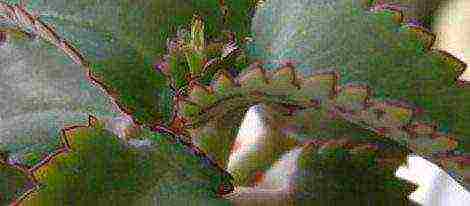Content
- 1 Difficulties in growing homemade citrus plants
- 2 Species suitable for growing at home
- 3 Cuttings
- 4 Tips
- 5 Planting material - seeds
- 6 How to grow a tangerine
- 7 Tangerine care
- 8 Watering and replanting
- 9 How to grow an orange tree
- 10 Bloom
- 11 Indoor lemons
- 12 For lovers of exotic
- 13 Features of growing citrus fruits
- 14 Lemon Tree
- 15 Indoor tangerines
- 16 Orange
- 17 Calamondin
- 18 Grapefruit
- 19 Citron
- 20 Video "Growing citrus at home"
- 21 Caring for citrus plants in the apartment
- 22 Reproduction of indoor citrus fruits
- 23 Diseases and pests
- 24 Conditions for growing citrus fruits (video)
Growing citrus indoor plants at home is an interesting activity, but far from simple. Therefore, those who believe that it will be enough to plant a seed in the ground, and that's all - lemons for tea are no longer necessary to buy. Without special knowledge, the first harvest of citrus indoor plants, if they do, will not be earlier than twenty years later.
But if you know some of the nuances and grow correctly, observing all the rules, then you can enjoy the fruits much faster. But even here it is important not to make a mistake in choosing a variety. For growing on a windowsill, only those citrus indoor plants that have been grafted on seedlings of orange, lemon, grapefruit or kumquat are suitable. Those crops that were grown from cuttings cut from fruit-bearing trees have also proven themselves well.
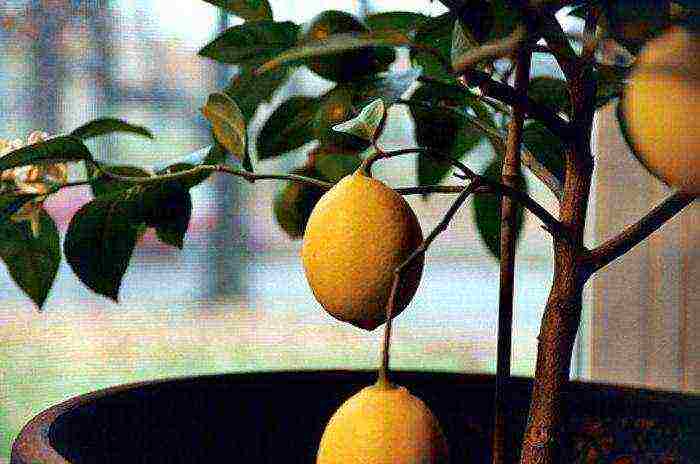
Difficulties in growing homemade citrus plants
It would seem that it is simpler: you need to go to a flower shop and buy a pot in which a flowering or already bearing citrus grows - a "golden orange", a Meyer's lemon, which is not very difficult to take care of at home, or a tangerine. The tree just needs to be brought home, placed on the windowsill in the right place, and started to water. But this is not at all the case, since it is really difficult to grow a lemon or tangerine at home, moreover, this process is somewhat different from caring for ordinary specimens.
Those plants that are sold today in flower shops most often come to the shelves from abroad, mainly from Holland. There they are kept in ideal conditions from the first day: the optimum temperature for growth, high humidity are maintained, supplementary lighting is supplied, and fertilizers for citrus indoor plants are constantly applied to the soil. When buying on dwarf trees, by the time they are sold, there may be a dozen or more fruits.
But after getting on the windowsills, beautiful citrus indoor plants immediately begin to face stressful conditions. In our houses, the illumination is much lower - several times, and the air (especially in winter) is incredibly dry compared to the greenhouse, and growth stimulants stop helping after a while.
Therefore, in conditions of a shortage of their internal resources, citrus indoor plants begin to throw all their strength into preserving the fruits with which they were so abundantly strewn in the store. And as a result, the vast majority of purchased "pets" die.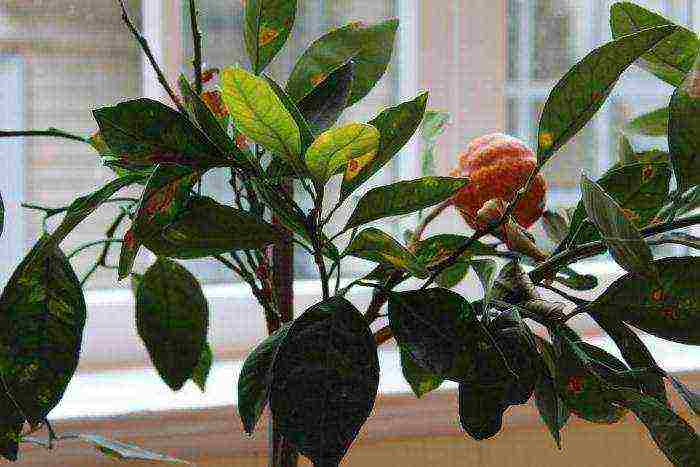
Species suitable for growing at home
Citrus crops have long been known to man. Their people have been actively cultivating for so long that it has become difficult to detect their wild-growing ancestors in nature. Most often, citrus fruits are cultivated outdoors in countries with tropical or subtropical climates. And it is from there that their fruits are delivered to store shelves in all corners of the planet.
A novice grower who cannot pay too much attention and time to a pet growing on his windowsill should choose varieties of indoor citrus plants that are easier to care for. If we talk about subspecies for a small apartment, then it is preferable for beginners to grow lemon, tangerine and trifoliate, since their growth is easier to restrain. In turn, oranges, grapefruits or pomelo, which are large in size, turn into a rather bulky tree after a couple of decades.
As for exotic varieties, today a close relative of mandarin is quite common - citrus kumquat nagami, as well as calamondin. Speaking of amazing varieties, the Hand of Buddha must also be mentioned.
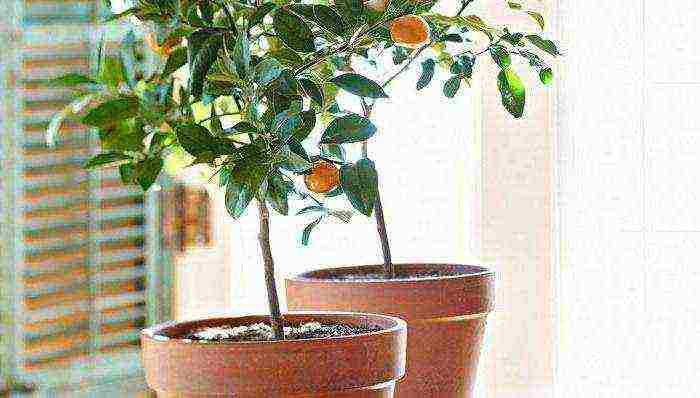
Cuttings
The most convenient option for those who decide to grow a citrus crop on their own will, of course, be a young plant, which was purchased in a specialized store. But a purchased tree does not always take root in the house for many reasons. However, if, after all, the culture has migrated from the store to the apartment, you need to contact the seller and get a recommendation from him for adapting the citrus to the new conditions.
First, the plant needs to be inspected. If there are fruits on it, then they will have to be cut off. For seven to ten days, citrus should be left in a store pot, and only then transplanted into a new one.
Tips
Citrus trees grown from material obtained by cuttings take root best at home. Of course, it will be difficult for beginners who have a poor idea of how to grow tangerine, lemon, etc.
The cuttings should be cut from a well-developed and healthy citrus tree. The length of the planting material should be between ten and twelve centimeters. It should have at least three buds. It is not recommended to use both too young and rather old shoots with dense wood.
The best time for harvesting cuttings is April. Rooting of the planting material can be carried out in a glass of water or in a soil consisting of earth and sand. In the latter case, the cutting should be covered, for example, with a plastic bottle. The roots will appear in about twenty days. After that, the rooted stalk can already be planted in a permanent pot.
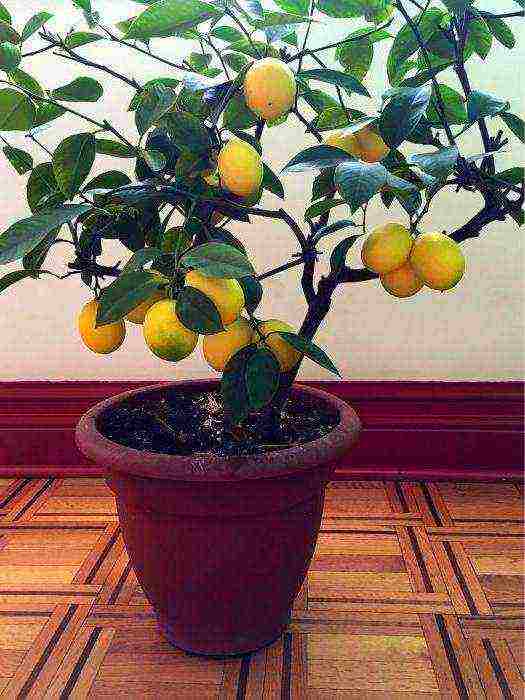
Planting material - seeds
You can often hear that a seed planted in the ground turns into a luxurious citrus tree over time. But, even despite the fact that growing tangerine or lemon from seeds is the most affordable way for amateurs to propagate this type of plant, the result is often unpredictable.
As a result, you can get a culture, the fruits of which will be much smaller than the parental form, or you can grow a new excellent pet. Judging by the reviews, the use of seeds pulled from fruits as planting material often leads to a lack of flowering in such seedlings.
The seedling begins to germinate in about a month and a half, and it should be transplanted at the stage of the appearance of five leaves.
How to grow a tangerine
After the juicy fruits of this citrus bought in the store are eaten, the remaining seeds can be used as planting material. For the greatest probability of success of the event, it is better to have more seeds, since definitely not all will germinate. Therefore, to obtain seedlings, you need to take a dozen seeds.

The planting material is placed in cheesecloth for several days and slightly moistened. This is necessary so that the bones, swelling, "hatch".
Tangerines can be grown at home in special citrus soil purchased at a flower shop. Although, in principle, almost any light soil is suitable for this culture.For example, in mixed in equal proportions turf and leafy soil, to which compost and rotted manure humus will be added, the tangerine will be very comfortable. Do not make peat-based soil. We must not forget about the need for drainage. Quite a long time should pass before the first shoots appear. The sprouts become noticeable only after two to three weeks, and sometimes even after a month.
Mandarin is a tree that grows rather slowly at home, and it sometimes stops growing. Therefore, you should not lose hope and enthusiasm, because when this citrus is provided with all the necessary conditions, it grows into a very beautiful tree.
Tangerine care
According to agronomists, tangerine is a very unpretentious tree to maintain, not only among citrus fruits, but also among many other plants, but it still requires observance of certain rules when leaving. The most important condition for him is an abundance of sunlight. Mandarin requires intense lighting up to twelve hours a day all year round.
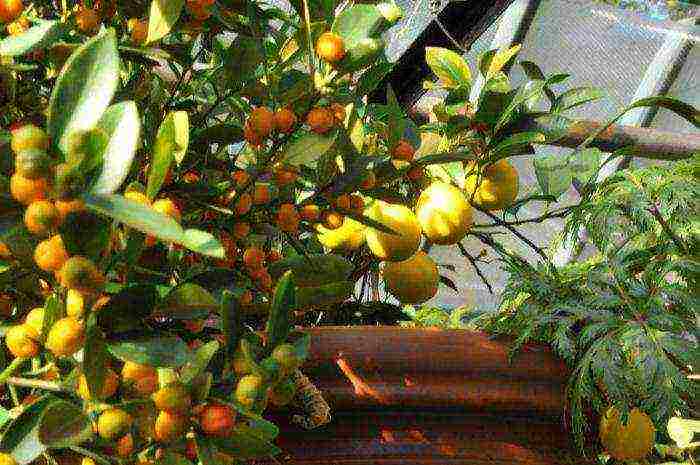
Watering and replanting
Mandarin is no less anxious about humidity. In the summer months, it should be watered abundantly without flooding, while in the winter the water supply should be reduced, periodically making sure that the soil does not dry out. In addition, it is necessary to spray the leaves daily, using filtered or boiled clean water for this purpose. You can compensate for the dryness of the air by placing a small decorative indoor fountain next to the tangerine. As it grows, the tree needs to be transplanted into larger pots periodically. It is best to carry out the movement in early spring. In this case, the new pot should have a diameter of three to five centimeters larger than the previous one.
Transplanting a tangerine tree is done by the transshipment method, while it is necessary to preserve the old earthen lump as much as possible so as not to accidentally harm the root system of the plant. For the first time, plants that have bloomed need to adjust the number of ovaries. In the first year, two or three fruits are left, in the second, seven or eight, and then about ten.
How to grow an orange tree
Home care for this type of citrus crop is not very different from the growing conditions for tangerine. Both a newly acquired tree and one that has been growing in the house for many years must be transplanted every year. The best time for this is spring, when the plant is just getting ready to expend energy for growth. For young crops, regular watering and spraying is a prerequisite for a normal existence.
Bloom
An orange tree, which is not very difficult to take care of at home, will give ovaries if the crown is correctly formed. This plant blooms and bears fruit on twigs at least five orders of magnitude, so you should not expect fruit to appear earlier than five years later. The crown is formed quite simply. When the branches reach a length of ten to fifteen centimeters, they are pinched. Soon, new shoots begin to awaken from the lateral buds, which should also be shortened. As a result, only after five years you can get an orange tree with many short shoots.
In this case, the room should be cool: 17-20 degrees. At higher temperatures, the fruits are not set, and the plant itself is sick or affected by pests.
Indoor lemons
Of all the varieties, Pavlovsky is considered the most unpretentious. This kind of lemon feels good even on northeastern or northwestern windowsills, it is comfortable in relatively dry air and with rare dressings.
The Panderosa variety is almost as unpretentious, but it needs more light. True, this type of lemon has a special "syndrome" that is found only in him: it produces too many flowers to the detriment of the growth of green mass.Therefore, extra buds must be constantly cut off.
Slightly less common is Meyer's lemon, home care for which involves following certain rules: if they are not followed, it grows very slowly. However, flower growers, even with little experience, can simply place the pot on a light windowsill, feed the plant from time to time, and spray it if necessary.
For lovers of exotic
Citrus fruits in our understanding are lemon, orange, tangerine. But there are representatives of this plant species that many of us have not even heard of. Of the tangerines, the Unshiu variety is interesting, which, in comparison with other representatives of the species, is relatively tolerant of poor lighting and unpretentious, just like Pavlovsky lemon.
Other close relatives of citrus fruits are Kumquat and Calamondin. Fans of original indoor plants should definitely get these types of plants.

Speaking of exotics, one should definitely mention the Buddha Hand variety. This citrus is distinguished by the unusual appearance of its fruit: it resembles a lemon in color, and outwardly - a fleshy brush on the hand. However, there is no edible pulp inside. Nevertheless, the fruit is so exotic that it should definitely be grown at home.
Citrus indoor plants are not only a wonderful decoration of the home, but also useful plants, the fruits of which are rich in vitamins and excellent taste. Growing these southern treats in the home, however, requires special conditions that differ for each type of fruit. In this article, we will look at how to grow citrus fruits in a pot in a city apartment.
Features of growing citrus fruits
Growing citrus fruits at home involves adhering to the basic rules of caring for southern crops.
First of all, indoor citrus fruits need a properly selected soil. For the base, you can take the soil "flower" or "lemon", diluting it one part at a time with foliage, sand and humus and three parts of turf. In structure, such a soil will be low-acid, lumpy and loose, which will provide free access of oxygen and moisture to the plant's root system.
It is better to plant the plant in clay pots, which, due to their properties, are excellent conductors of heat. In addition, these pots "breathe", which will allow excess moisture to evaporate without lingering in the soil.
Citrus fruits in pots need to maintain an optimal moisture level - at least 65%. The fruits grown in humid air will turn out to be juicy and tasty, but with an excess of humidity, they are threatened with rotting and falling off. Citrus houses should be watered as the soil dries up: in winter this happens once a month, in summer - once every 1-2 weeks. On hot days and during the heating season, the plant needs regular spraying.
In an apartment, most often citrus fruits stand on the windowsill, since it is there that the plant will be provided with sufficient access to light and heat. If there is not enough lighting (for example, on the north or north-west side of the apartment), then it is necessary to provide citrus with additional lighting using ordinary lamps with good heat transfer. The temperature during the entire period of development should not fall below +8 degrees. In winter, the temperature regime should be maintained in the region of + 12-15 degrees, and with the onset of spring - not lower than +18. Thanks to warm temperatures and high-quality lighting, the plant will begin to release buds, the flowering of which will mark the proximity of fruiting.
Reproduction of citrus fruits is carried out at the end of summer by separating the growing shoot from the main cutting. Such a shoot is carefully trimmed and cleaned from the bark below, after which it is lowered into a pre-prepared pot with nutrient soil, which is fertilized with moss, manure and a small amount of peat. The pot must have holes in the bottom, which are necessary for the outflow of excess water.
You can propagate by seeds and grafting, but for this it is better to familiarize yourself with the varietal characteristics of the plant, since even fertile trees during reproduction can become inedible.
Pruning citrus fruits is essential not only to keep the plant healthy, but also to create a beautiful round shape that can be created after the second year of the plant's life. If the aesthetic side requires pruning too long shoots, then the vegetative one - too thick. Shoots that grow inside the crown and hinder the free development of buds due to their large numbers should also be removed. Pruning is done in the spring, all cuts are made at an angle.
If you are interested in how to grow a citrus tree on your own, then there are two options - cuttings or from a stone at home. The apartment is ideal for this, since it is possible to create conditions in it that are as close as possible to those of a greenhouse. Growing from cuttings is recognized as the best method, since this method will provide you with fruits in the coming years, while plants obtained from seeds begin to bear fruit at least 10 years later.
Consider the varieties of citrus trees for an apartment in more detail.
Lemon Tree
The lemon tree is an unpretentious and persistent citrus fruit that shows good fruiting and hardiness results. In addition, lemon gets along well in low light and moisture conditions. Keep in mind, however, that the lemon tree needs regular pruning and fertilization, as a well-groomed tree will provide you with delicious and aromatic fruits.
Lemon is planted from seeds or cuttings. As already mentioned, plants from seeds will begin to bear fruit only after 10-15 years. For development, planting material of varieties Pavlovsky, Maikop, Novogruzinsky is used - these are varieties specially created for home conditions.
Lemon care is simple: regular watering, bait, crown pruning. The only thing that can be difficult is the need to replant the lemon tree in a larger pot every year.
Indoor tangerines
Mandarin, like lemon, requires regular transplanting in the spring. In addition, it is more thermophilic and picky about the level of humidity. It is better not to keep home tangerine at temperatures below +20 degrees, otherwise the plant will quickly die. However, a clear advantage of the species is its faster period of entry into fruiting - within 5–6 years, the development of fruits is possible.
Mandarin, in addition to the requirements for lighting and moisture, also needs regular feeding and treatment from pests. Unfortunately, these plants are very susceptible to aphids, spider mites and mealybugs. Also, the problem of mandarin is the complexity of the flowering process, which often needs stimulation.
Orange
The orange tree in the apartment is not only a supplier of sweet fruits throughout the year, but also a source of wonderful aroma. However, the problem with the orange is its poor tolerance to low temperatures, which will require constant temperature maintenance at 18-24 degrees. In addition, an orange requires direct sunlight for at least 2 hours a day, but no more than 3 hours, which is difficult when choosing a growing location, since, with all this, the tree does not like anxiety and rearrangements.
This type of citrus fruit needs regular watering and spraying, which should be carried out at least 2 times a week. The best varieties of homemade oranges are Gamlin, Pear-shaped Korolek, Washington Navel and Adjarian.
Calamondin
Calamondin is a citrus plant with a mandarin-like fruit appearance. However, unlike the latter, calamondin is less whimsical to light and moisture, moreover, it is very frost-resistant for a tropical plant.The tree reaches a height of 90 cm, and bears fruit all year round.
Calamondin is best grown from cuttings or store-bought annuals. Such a tree will begin to bear fruit as early as 2-3 years.
Despite the resistance to cold weather, the optimal growing temperature in summer is 21-25 degrees with a humidity of 70%, and in winter - 10-16 degrees with a humidity of 50%. This regime will provide the plant with healthy and abundant fruiting.
Grapefruit
Homemade grapefruit can be obtained from Duncan and Marsh varieties. This variety of citrus fruits resembles a lemon in terms of keeping conditions. However, the grapefruit needs more abundant and frequent watering and the maximum amount of sunlight.
Citron
Citron is a plant with very large yellow fruits (from 15 cm in length) and thick skin. For home cultivation, the varieties Pavlovsky, Buddha's Hand and Mir are suitable. It should be remembered that the size of the fruit requires a tall tree (1.5 m), which should provide an abundance of sunlight and warm temperatures throughout the year.
Video "Growing citrus at home"
From this video you will learn how to grow and care for lemon, tangerine, lime at home.
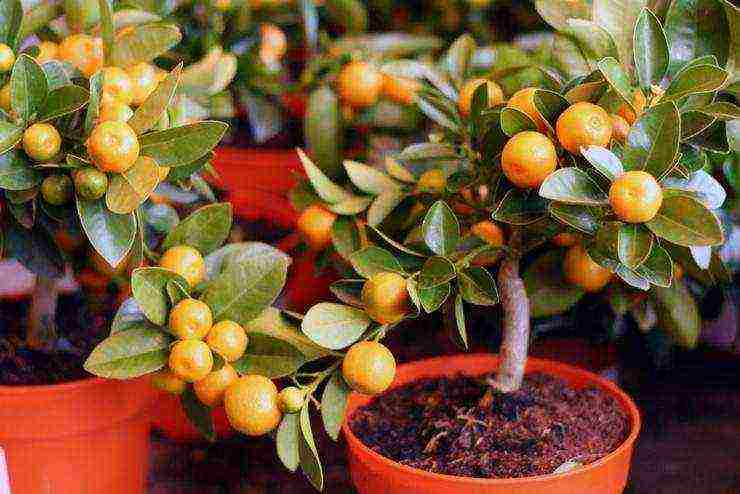
Many representatives of citrus fruits, when favorable conditions are created, thrive and grow in various residential and administrative premises. The most popular of them is lemon, it can be found in apartments and offices, school classes and preschool institutions, clinics and shops. Raising this popular pet is not easy, you have to spend a lot of time and effort on growing and caring for it. Mandarin, orange, lime, pomelo, and grapefruit require the same attention. All of them have numerous useful qualities, one of which is the presence of biologically active substances in the leaves that can destroy pathogenic bacteria. To create all the necessary conditions for citrus fruits in a house or apartment is within the power of every lover of indoor plants.
Caring for citrus plants in the apartment

Location and lighting
The place for growing citrus indoor plants should not be on the windowsill from the north of the house, near a microwave oven, in drafts, and near central heating batteries or other heating appliances. Citrus fruits belong to shade-tolerant crops, therefore it is more favorable to place them on the east or west window, but it is also possible at a short distance from the southern window sill.
Temperature
For plants, places where warm and cold air is found, as well as elevated air temperatures, are dangerous. In the presence of at least one of these unfavorable moments, the leaves on citrus fruits begin to fall off.
In the period from November to February, when the crops are in a dormant period, a special maintenance regime is introduced - low air temperature in the room, the absence of any water procedures (spraying and watering) and fertilizing.
Air humidity
The humidity level should be high. It can be maintained with the help of daily spraying, the water temperature should not be lower than 25 degrees. Overdried indoor air is painfully tolerated by citrus plants.
Watering
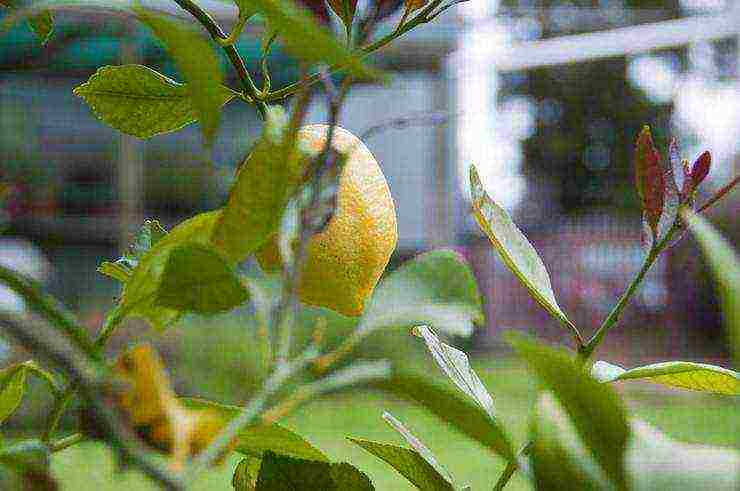
It is not recommended to use tap water for irrigation, the presence of chlorine in it will negatively affect indoor pets. Irrigation water (with a temperature of 20-22 degrees) should be settled and slightly acidified. To do this, add a few drops of vinegar to it.
Pot selection
The ideal pot material is unglazed fired clay or wood. There must be drainage holes and a good drainage layer at the bottom of the flower container.
Requirements for the composition of the soil
Indoor citrus fruits will fully develop only in a special substrate for this type of plant.It is recommended to purchase high-quality soil mixture only in specialized shops for flower growers, so that its quality is not in doubt.
Top dressing and fertilizers
It is necessary to feed exotic citrus plants regularly from February to November. You can use organic fertilizers or mineral fertilizers containing nitrogen, potassium and phosphorus.
Reproduction of indoor citrus fruits
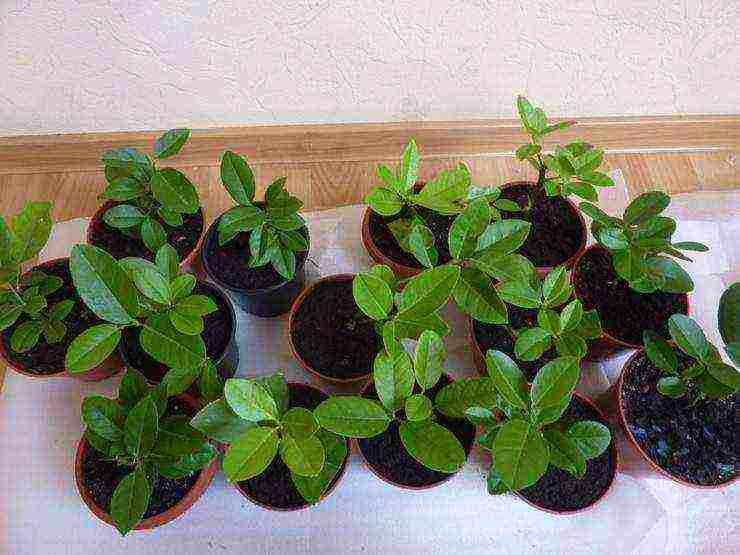
Lemons, tangerines, oranges and other exotic species can be propagated by seeds, cuttings and grafts. Every florist dreams of growing an exotic citrus plant from an ordinary seed, which will not only germinate and sprout, but will eventually turn into a small tree and give many fruits.
Growing citrus fruits from a seed, from the very beginning of its life path, the plant's immunity is strengthened and its resistance to life increases. After all, a tender young culture has to adapt to its unusual conditions of existence from the very first days. Usually, there are no big problems with germinating seeds, but flowering and fruiting will have to be expected from 7 to 15 years. The taste of the fruit also leaves much to be desired. In order for the culture to bloom much earlier, you will need to be vaccinated. Usually, experienced florists and gardeners recommend using cuttings of citrus fruits that are already bearing fruit as a scion.
When growing exotic crops indoors, it must be borne in mind that plants can reach great heights. It is better to immediately purchase seeds of dwarf species and varieties for planting.
Seed propagation
It is recommended to plant freshly harvested seeds taken directly from the fruit. Planting depth - no more than 3 cm. The planting container should hold a volume of about 2 liters with mandatory drainage holes at the bottom. Drainage is poured at the bottom, and then a special substrate for citrus fruits. After planting, the pot must be covered with a glass jar or foil to create greenhouse conditions in which seedlings will appear much earlier. Depending on the variety and type of culture, seedlings will appear in the interval from 7 days to 2 months. If several shoots have appeared from one seed, then over time it is necessary to leave only one stronger and stronger plant.
Propagation by cuttings
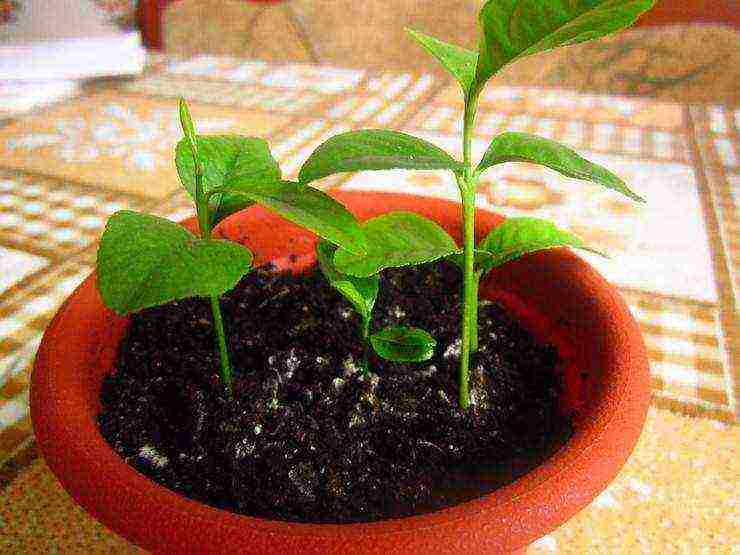
For rooting, you need to take the apical cuttings and plant them in wet river sand at a slight slope, covering the top with a cut plastic bottle made of transparent material. The favorable temperature for root formation is 20-25 degrees. The place should be well lit, but protected from direct sunlight. The first roots may appear in about a month, after which the plant is transplanted into a special soil mixture. When transplanting, it is necessary to take care of the root part, as it can be easily damaged.
This method is considered the most common, because it allows you to keep all the best quality characteristics of the mother plant. Flowering and fruiting occurs much earlier than with seed reproduction.
Graft
Vaccination can be carried out by budding or copulating. The graft and rootstock can be from different types of citrus fruits. It is recommended to use lemon, orange or grapefruit for rootstock.
Diseases and pests
Possible pests of citrus fruits as indoor crops are aphids, spider mites, scale insects, mealybugs, possible diseases - anthracnose, wartiness and gommosis. The emerging diseases are difficult to treat, so you need to try to prevent them. At the first signs of illness, it is recommended to "help" the plants. This help consists in the urgent removal of the affected leaves, buds and fruits, then the plant will direct all its strength to recovery and preservation of healthy parts.
The main and most common cause of diseases and pests is a violation of conditions of detention and rules of care.With increased attention to indoor pets and strict adherence to their requirements and preferences, such a danger does not threaten.
Conditions for growing citrus fruits (video)
